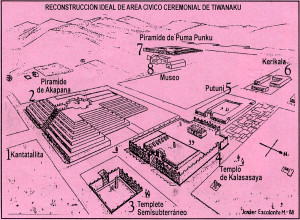Javier Escalante Moscoso
Pumapunku *
 Pumapunku is a terraced earthen mound, faced with blocks and an important part of the Tiwanaku archaeological site on the Bolivian Altiplano. It has unique architectural features including the use of building blocks with up to 80 faces on them. The Tiwanaku site is pre-Inca and has given its earliest radiocarbon date as 536-600 AD and was in use until circa 1000 AD(a), which is a far cry from the flawed 12,000-15,000 BC date claimed by Posnansky(e)(f). Details of how these late dates were arrived at are available in a paper by Jason Yaeger and Alexei Vranich on the Academia.edu website(j).
Pumapunku is a terraced earthen mound, faced with blocks and an important part of the Tiwanaku archaeological site on the Bolivian Altiplano. It has unique architectural features including the use of building blocks with up to 80 faces on them. The Tiwanaku site is pre-Inca and has given its earliest radiocarbon date as 536-600 AD and was in use until circa 1000 AD(a), which is a far cry from the flawed 12,000-15,000 BC date claimed by Posnansky(e)(f). Details of how these late dates were arrived at are available in a paper by Jason Yaeger and Alexei Vranich on the Academia.edu website(j).
As with so many other enigmatic ancient sites, various members of the ‘lunatic fringe’ have attributed the construction at this location to either ancient astronauts or Atlanteans or an exotic combination of both, based on either over-fertilised imaginations or flawed data or again, both. Jason Colavito has written a critique of some of the more silly suggestions(b). In September 2024, Ancient Aliens revisited Puma Punku (S20.E20), recycling silly claims about extraterrestrial visitors. Once again, Colavito was obliged to put fingers to keyboard to review this latest episode(l).
Ancient astronaut advocate Von Däniken[1147.221] and Brien Foerster(d) among others have claimed that the stones of Pumapunku were composed of diorite, an exceptionally hard stone, which would have required a modern diamond-tipped drill to work it. The implication is that only Atlanteans with their advanced technology or extraterrestrials could have worked the stone with such precision.
Brien Foerster also published a paper on the Academia.edu website in Feb. 2023 in which he decries “The extraction, wanton destruction, and recycling of much of the Puma Punku site that can be easily seen in the small nearby town also called Tiwanaku, where many of the buildings, including the church, contain the telltale grey andesite blocks, with smooth flat surfaces, which clearly came from Puma Punku.” He also points out that while Tiwanaku has been declared a World Heritage Site by UNESCO, Puma Punku has received little attention(k).”
However, Colavito and Michael Heiser(c) have pointed out that this identification is untrue and that they were composed of the softer andesite and red sandstone. Apart from this, the Code of Hammurabi was incised on diorite, without Atlantean or extraterrestrial assistance, 2,000 years before the development of Pumapunku!
Joseph Davidovits who controversially proposed that Giza’s Great Pyramid stones had been cast rather than carved has also claimed that other well-known structures had been created in a similar manner, such as at Tiwanaku and Puma Punku in Peru(g) and Easter Island(h).
Javier Escalante Moscoso is an architect with a degree in archaeology who has extensively excavated and surveyed the Tiwanaku monuments. (see map above).
A fully illustrated guide to the monuments of Tiwanaku/Puma Punku is an excellent introduction to the site including a map by Moscoso(i).
(a) https://skeptoid.com/episodes/4202
(b) https://www.jasoncolavito.com/blog/review-of-in-search-of-aliens-s01e07-the-mystery-of-puma-punku
(c) See: https://atlantipedia.ie/samples/archive-2803/
(d) https://hiddenincatours.com/posts/videos/#!/keyword_filter=Puma%20Punku (now password protected) *
(e) The age of Tiwanaku (Tiahuanaco) Site, Bolivia (archive.org)
(f) https://www.mail-archive.com/ctrl@listserv.aol.com/msg62910.html
(g) https://www.geopolymer.org/archaeology/tiahuanaco-monuments-tiwanaku-pumapunku-bolivia/
(h) https://www.geopolymer.org/library/video/they-came-from-america-to-build-easter-island/
(i) Tiwanaku, the mysterious pre-Inca capital – mapaymochila.es
(k) (99+) The Enduring Enigma Of Puma Punku in Bolivia | Brien Foerster – Academia.edu
(l) https://www.jasoncolavito.com/blog/review-of-ancient-aliens-s20e20-resurrecting-puma-punku
